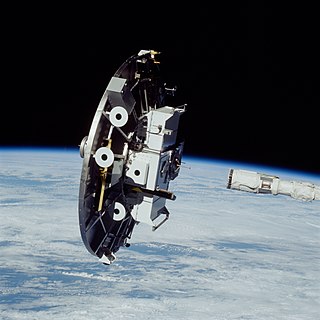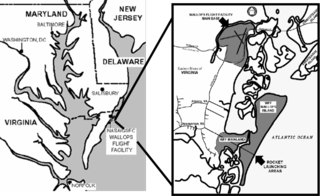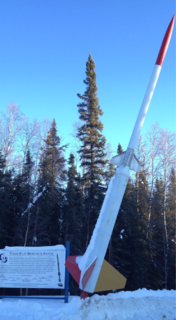
STS-80 was a Space Shuttle mission flown by Space Shuttle Columbia. The launch was originally scheduled for 31 October 1996, but was delayed to 19 November for several reasons. Likewise, the landing, which was originally scheduled for 5 December, was pushed back to 7 December after bad weather prevented landing for two days.

STS-105 was a mission of the Space Shuttle Discovery to the International Space Station, launched from Kennedy Space Center, Florida, 10 August 2001. This mission was Discovery's final mission until STS-114, because Discovery was grounded for a refit, and then all Shuttles were grounded in the wake of the Columbia disaster. The refit included an update of the flight deck to the glass cockpit layout, which was already installed on Atlantis and Columbia.
Pegasus is an air-launched launch vehicle developed by Orbital Sciences Corporation (OSC) and now built and launched by Northrop Grumman. Capable of carrying small payloads of up to 443 kg (977 lb) into low Earth orbit, Pegasus first flew in 1990 and remains active as of 2021. The vehicle consists of three solid propellant stages and an optional monopropellant fourth stage. Pegasus is released from its carrier aircraft at approximately 12,000 m (39,000 ft), and its first stage has a wing and a tail to provide lift and attitude control while in the atmosphere. Notably, the first stage does not have a thrust vector control (TVC) system.

Wallops Flight Facility (WFF) is a rocket launch site on Wallops Island on the Eastern Shore of Virginia, United States, just east of the Delmarva Peninsula and approximately 100 miles (160 km) north-northeast of Norfolk. The facility is operated by the Goddard Space Flight Center in Greenbelt, Maryland, and primarily serves to support science and exploration missions for NASA and other Federal agencies. WFF includes an extensively instrumented range to support launches of more than a dozen types of sounding rockets; small expendable suborbital and orbital rockets; high-altitude balloon flights carrying scientific instruments for atmospheric and astronomical research; and, using its Research Airport, flight tests of aeronautical research aircraft, including unmanned aerial vehicles.

The Columbia Scientific Balloon Facility (CSBF) is a NASA facility responsible for providing launch, tracking and control, airspace coordination, telemetry and command systems, and recovery services for unmanned high-altitude balloons. Customers of the CSBF include NASA centers, universities, and scientific groups from all over the world.

Orion is the designation of a small American sounding rocket. The Orion has a length of 5.60 meters, a diameter of 0.35 m, a launch weight of 400 kg, a launch thrust of 7 kN and a ceiling of 85 kilometers. The Orion, built by NASA Goddard Space Flight Center's Wallops Flight Facility, is also used as an upper stage of sounding rockets, usually paired with a Terrier missile as the first stage.

The Poker Flat Research Range (PFRR) is a launch facility and rocket range for sounding rockets in the U.S. state of Alaska. The world's largest land-based rocket range, it is on a 5,132-acre (20.77 km2) site about 30 miles (50 km) northeast of Fairbanks and 1.5 degrees south of the Arctic Circle. More than 1,700 launches have been conducted at the range to study the Earth's atmosphere and the interaction between the atmosphere and the space environment. Areas studied at PFRR include the aurora, plasma physics, the ozone layer, solar proton events, Earth's magnetic field, and ultraviolet radiation. Rockets launched at PFRR have attained an apogee of 930 miles (1,500 km).
Scramjet programs refers to research and testing programs for the development of supersonic combustion ramjets, known as scramjets. This list provides a short overview of national and international collaborations, and civilian and military programs. The USA, Russia, India, and China (2014), have succeeded at developing scramjet technologies.

Antares, known during early development as Taurus II, is an expendable launch system developed by Orbital Sciences Corporation and the Yuzhnoye Design Bureau to launch the Cygnus spacecraft to the International Space Station as part of NASA's COTS and CRS programs. Able to launch payloads heavier than 8,000 kg (18,000 lb) into low-Earth orbit, Antares is currently the largest rocket operated by Northrop Grumman. Antares launches from the Mid-Atlantic Regional Spaceport and made its inaugural flight on April 21, 2013.
A number of Suborbital spaceflights were conducted during 2008. These consist mostly of sounding rocket missions and missile tests, and include other flights such as an ASAT firing. Between the start of the year and 16 July, at least 43 publicly announced suborbital spaceflights were conducted, the first of them on 11 January.

The Terrier Orion sounding rocket is a combination of the Terrier booster rocket with the Orion rocket used as a second stage. This spin stabilized configuration is most often used by the Goddard Space Flight Center, who operate out of the Wallops Flight Facility for sounding rocket operations. The system supports payloads ranging from 200 to 800 pounds, and is capable of achieving altitudes as high as 120 miles (200 km), but at least 50 miles (80 km), depending on payload size.

The Terrier Malemute is a two-stage American sounding rocket typically used for smaller payloads. Both the Terrier first stage and the Malemute second stage use solid fuel. The Terrier burns for approximately 5.2 seconds, and the Malemute burns for approximately 21.5 seconds. The first stage booster consists of a surplus Navy Terrier MK 12 Mod 1 rocket motor with four 0.22 m2 (340 sq in) fin panels arranged in a cruciform configuration. The Terrier rocket booster has a diameter of 460 mm (18 in). The second stage solid rocket is a Thiokol Malemute TU-758 rocket motor, specially designed for high altitude research rocket applications. Apogee is approximately 400 km (220 nmi) for a 230 kg (510 lb) payload or 700 km (380 nmi) for a 41 kg (90 lb) payload. For a payload weight of 200 lb (91 kg), the acceleration during the boost phase is 26 g.

Terrier Oriole is an unguided two-stage rocket system which is primarily used by the Goddard Space Flight Center out of the Wallops Flight Facility as a sounding rocket. The system uses a Terrier first-stage booster attached to an Oriole second-stage rocket. The system can carry payloads between 800 to 1,500 pounds up to an altitude of 320 kilometres (200 mi). It is also used to test ballistic missile defense systems, under the name ARAV-B.

Antares A-ONE mission was the maiden flight of Orbital Sciences Corporation' Antares launch vehicle including the ascent to space and accurate delivery of a simulated payload, the Cygnus Mass Simulator (CMS), which was launched 21 April 2013. It was launched from Pad 0A at the Mid-Atlantic Regional Spaceport (MARS), Wallops Flight Facility, Virginia. The simulated payload simulates the mass of the Cygnus cargo spacecraft. This dummy payload was sent into an orbit of 240 km × 260 km with an orbital inclination of 51.6°, the same launch profile it will use for Orbital's upcoming cargo supply missions to the International Space Station (ISS) for NASA.

The Equatorial Vortex Experiment (EVEX) is a NASA-funded sounding rocket mission to better understand and predict the electrical storms in Earth's upper atmosphere. As part of this experiment, two rockets were launched for a twelve-minute journey through the equatorial ionosphere above the South Pacific. These rockets were launched from Kwajalein Atoll in the Marshall Islands during a period of April 27 to May 10, 2013.

Orbital-3, also known as Orb-3, was an attempted flight of Cygnus, an automated cargo spacecraft developed by United States-based company Orbital Sciences, on 28 October 2014. The mission was intended to launch at 22:22:38 UTC that evening. This flight, which would have been its fourth to the International Space Station and the fifth of an Antares launch vehicle, resulted in the Antares rocket exploding seconds after liftoff.
Small Payload Quick Return (SPQR) is a NASA Ames Research Center concept to return small payloads from orbit.

The NASA Sounding Rocket Program (NSRP) is a NASA run program of sounding rockets which has been operating since 1959. The missions carried out by this program are primarily used for scientific research, particularly low gravity and material based research. NASA's sounding rocket program is commonly used by colleges and universities for upper atmosphere research.
Rapid Acquisition Imaging Spectrograph Experiment or RAISE is a NASA funded series of sounding rocket missions to study the Sun in extreme ultraviolet. RAISE is supported by NASA's Sounding Rocket Program at NASA's Wallops Flight Facility in Virginia. NASA's Heliophysics Division manages the Sounding Rocket Program.

Cislunar Autonomous Positioning System Technology Operations and Navigation Experiment (CAPSTONE) is a lunar orbiter that will test and verify the calculated orbital stability planned for the Gateway space station. The spacecraft is a 12-unit CubeSat that will also test a navigation system that will measure its position relative to NASA's Lunar Reconnaissance Orbiter (LRO) without relying on ground stations.















